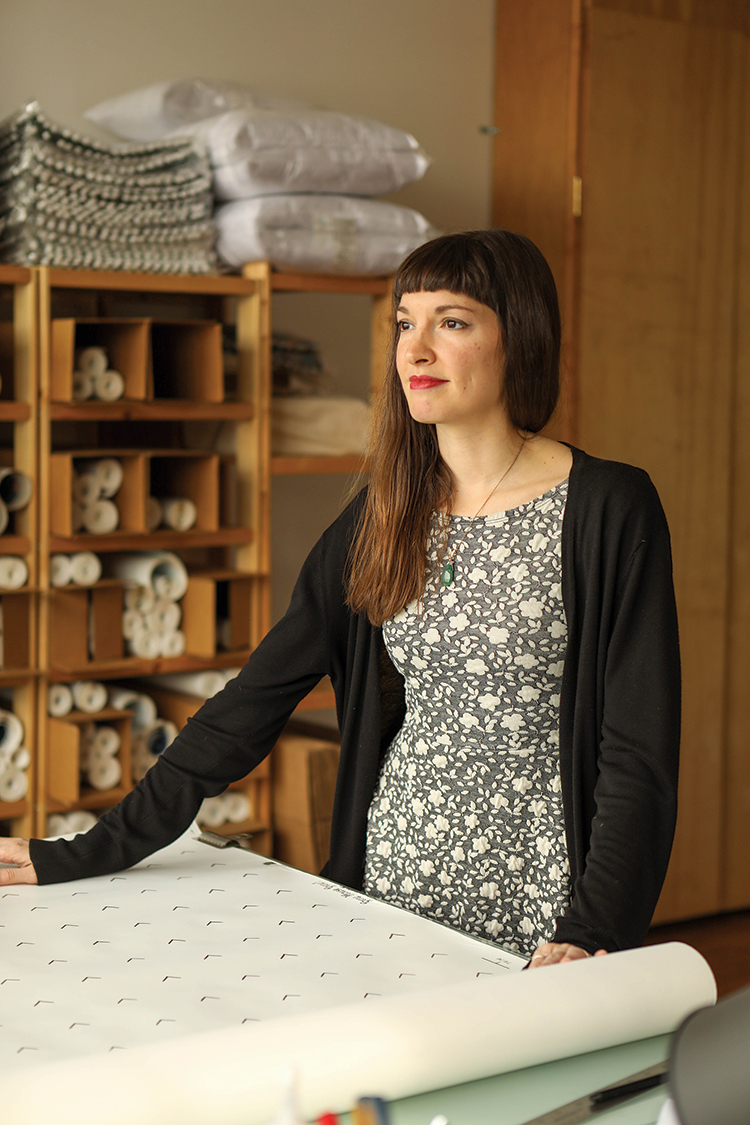
My mom is from Cuba and my dad is from the Northeast, so it was a good balance growing up down South in Atlanta, GA. I moved on to NYC after graduating from college, and have been here in beautiful Brooklyn ever since. I do miss real sweet tea and hot boiled peanuts, though. And trees!
When I was four, I wanted to be an astronaut. It didn’t last long, because my earliest memory of wanting to be an “artist” came soon after, probably around five. I had no idea what that really meant, but it was what gave me the most joy and relieved my mind as I was growing up. I did a lot of drawing when I was young, as opposed to three-dimensional work. On that note, I also did a lot of deconstructing. I’d take old telephones, lamps, whatever was lying around in the basement and pull them apart to try to figure out how they worked. I was interested in both sides of the coin; makin’ and breakin.’
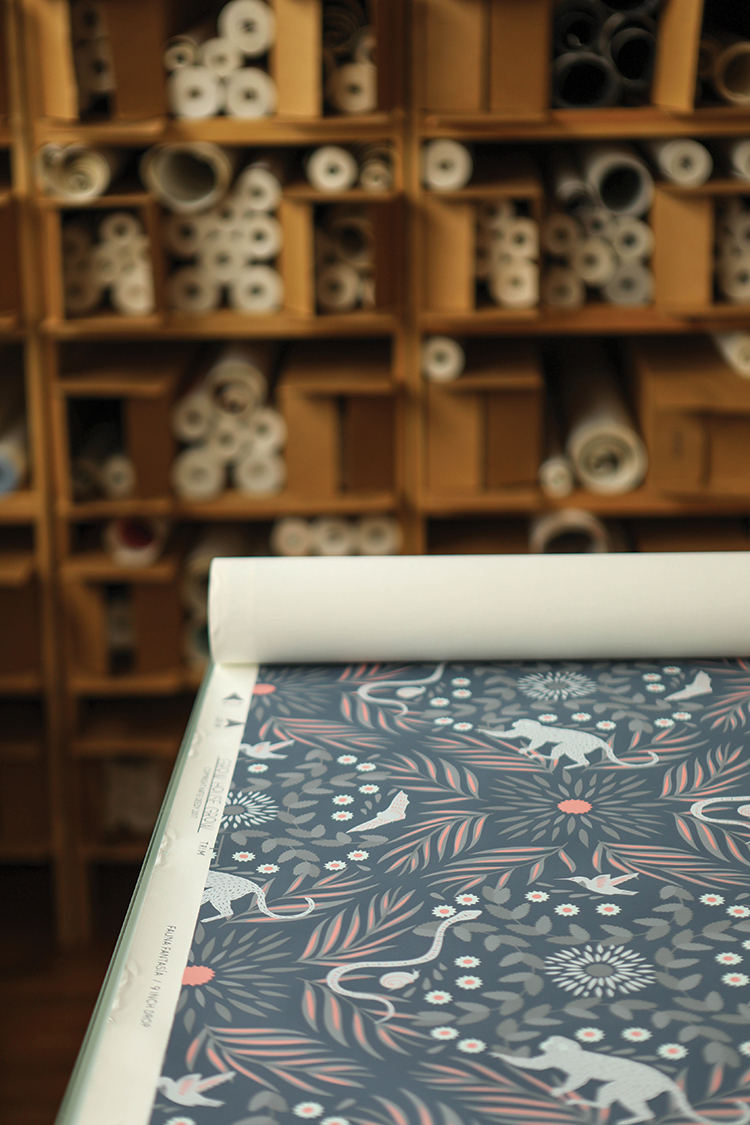
I always felt like having a story or a “meaning” behind my artwork was important. I began working towards a career in illustration for that reason. Ultimately that track wasn’t for me, but I still found a way to use my love of history, mysteries, cultures, and overall storytelling. My path led me to pattern making, which grew into wallpaper designs based on my various inspirations. I try to make work that is interesting or beautiful without knowing the story behind it, but in the end the narrative is what gives it depth.
Designing a wallpaper can take anywhere from a day to several months. It usually begins with a seed of inspiration; a strange place, an interesting story, or a surprising person from history. Whatever gets my curiosity walking down a new path. I spend a lot of time thinking about imagery and design that can relate to that person, place, event, or thing; what colors and pattern elements were used at that time and place? Throughout the process of designing wallpapers I am always sketching loosely on paper. I then refine my favorite drawings to create concepts that could be used for different wallpaper patterns.
Once we select a concept and finalize a wallpaper design, we transfer it into Adobe Illustrator so that I can quickly and easily create repeats and ensure alignment and flow. It took me a long time to be comfortable drawing on the computer, but with pattern work it’s an essential tool in the toolbox.
All of my pattern work is inspired by narrative, which enriches what I make.
The next step is to build our screens for printing. Each color on a pattern gets its own screen, which essentially acts as a stencil. Screen building is a technical art, and involves stretching fine mesh over a frame, coating it in a photosensitive film, and then transferring the design by using light to “burn” the image in. Most of our patterns have between two and six screens, which are numbered and layered in order to create the rich, textured pattern of the finished paper.
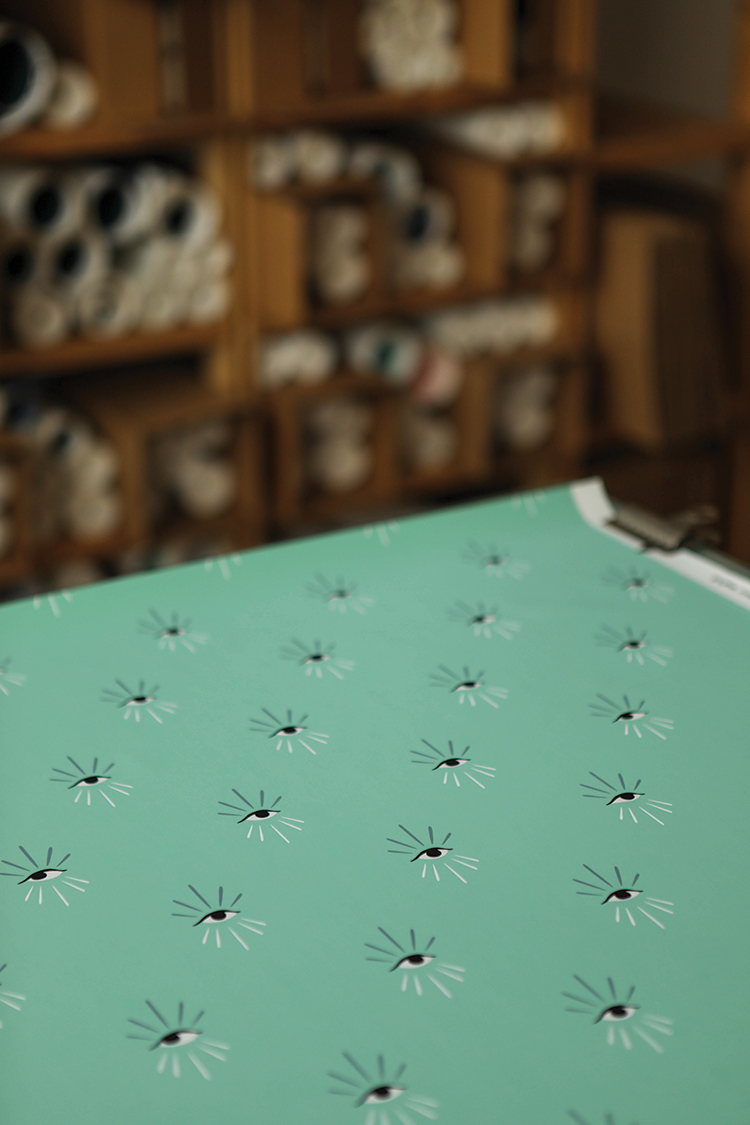
Once all the screens are shot, we take them to the print shop. The building we print in is an old converted bowling alley in upstate New York, situated on a lake and surrounded by a little town. Where the lanes once were, long tables have been built to give us enough space to print five consecutive rolls per table — about 75 feet. Each screen is quite large; the actual print on paper is 36″ × 30.”
The screen printing process is all done by hand, one color at a time with inks which are hand-mixed, which means slight variation can occur from batch to batch — but I prefer this method to a digital print any day. I’m a stickler for color, and can sometimes spend more time perfecting the exact hue I’m going for than creating the pattern itself. I often work from color swatches, but am always looking for color inspiration around me; old illustrations, rare bits of nature in the city, etc.
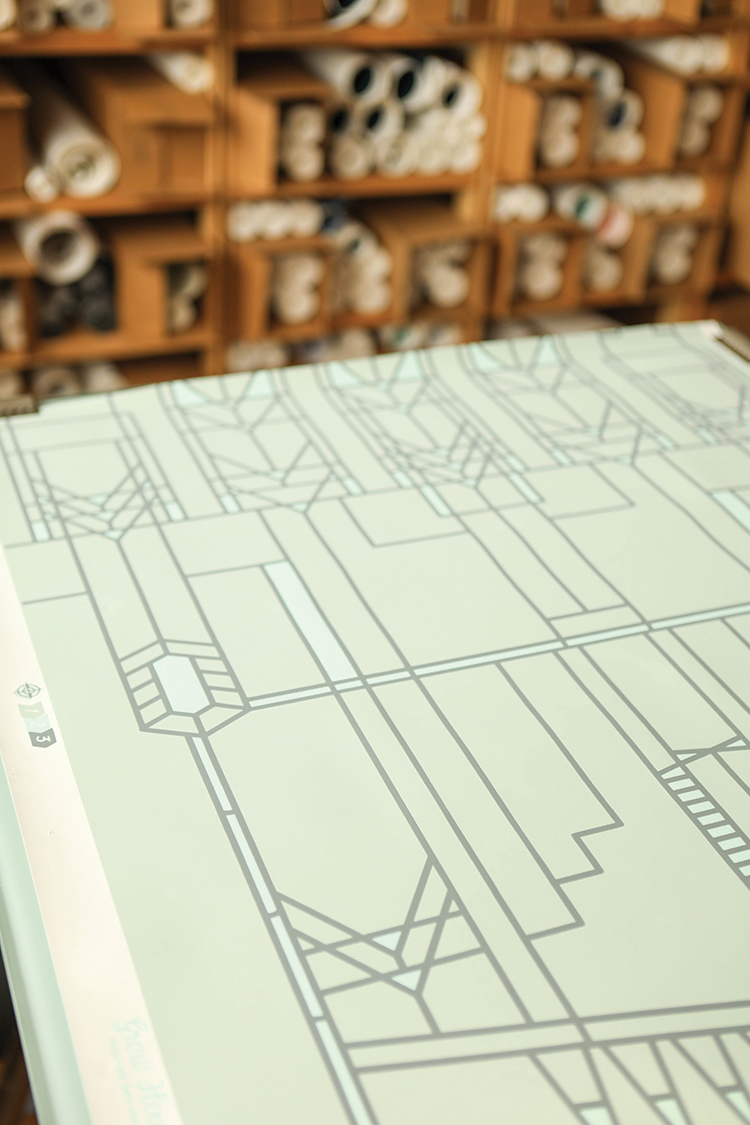
Each screen is smothered in the ink(s) and stenciled onto the paper until all 75 feet is glowing with pattern. Printing requires two people to ensure consistency and alignment. Each screen will go down the print table 25 times, which means some of our patterns will take 150 actual prints per table.
In a digital world where products seem to pop out of a machine whole, watching this process feels like magic. It’s also exciting seeing a small idea turn into a massive final product. The anticipation of getting that first batch of rolls in from the print shop will never, ever get old.
Once the colors are screened and the paper dries the long strips of wallpaper are then cut down into smaller bolts of two and three rolls. Because of the hand-mixed inks and the slight variations between print run we ensure that each order gets pulled from the exact same dye lot, so customers get a perfect match every time. The rolls are then packaged by hand for delivery.
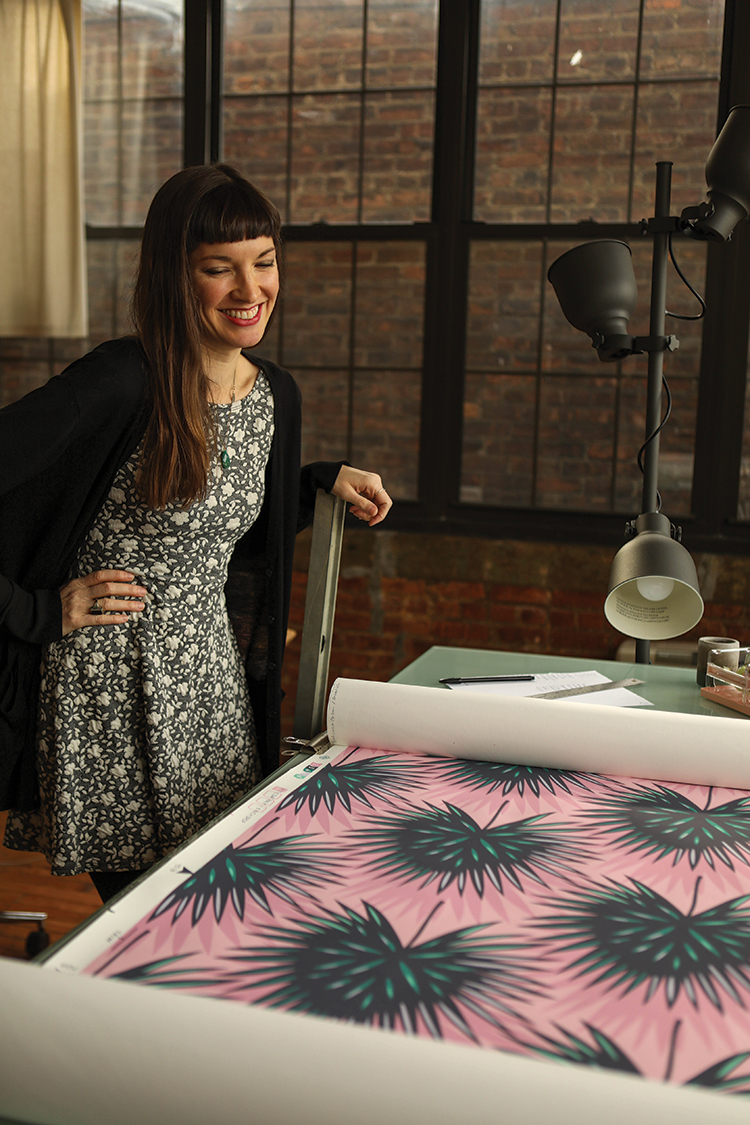
Wallpaper lines included in our portfolio are our Sister City Collection (inspired by towns around the world and their historical and cultural connections), our Codex Collection (based on unusual and noteworthy manuscripts from around the world), and our Cuba Collection (pulled from family stories, as an autobiographical line).
I design handmade cement tiles as well. My family is Cuban, and I wanted to produce a traditional Cuban product in patterns that were a little more contemporary. These don’t have specific stories behind them, but they do have little inspirations. They’ve been a wonderful way for me to think differently about pattern — the way the layouts work are much different than wallpaper. They’ve been a wonderful addition to my product line!
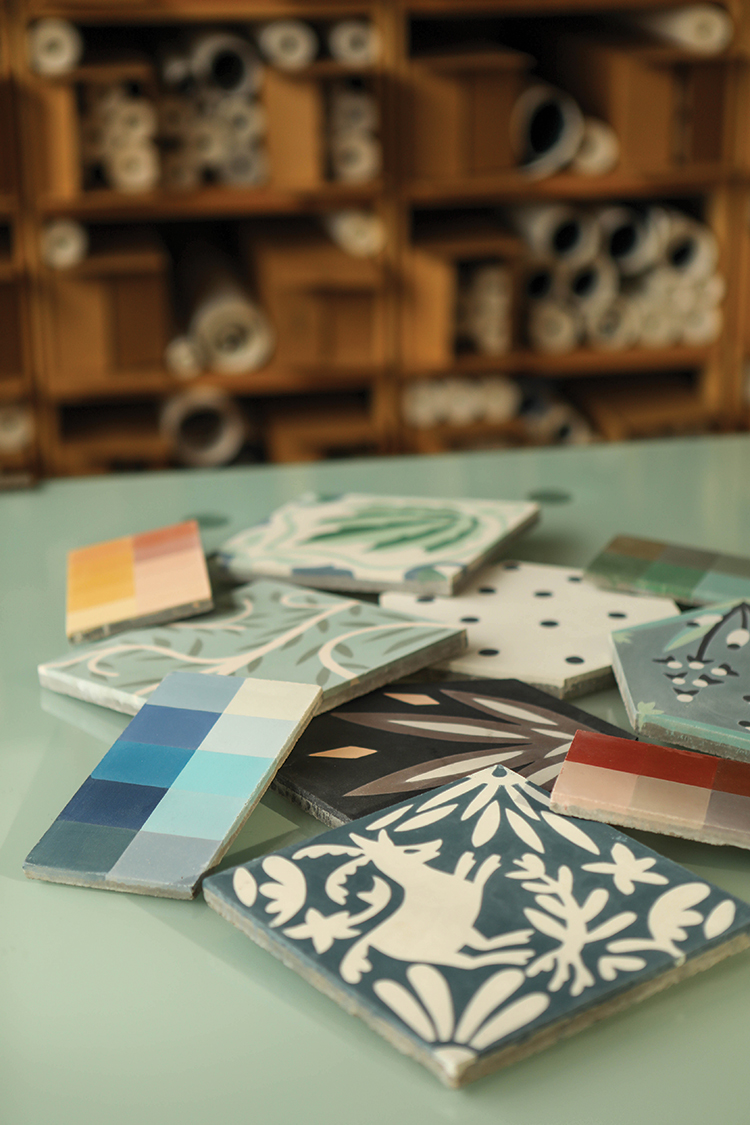
In some cases, the cement tiles are intended to support a wallpaper pattern; for example, our most popular tile — Otomi — is essentially the same pattern as our Jardin wallpaper, but with a slightly different scale and layout. Most customers will use the tiles and wallpapers independently of one another, but when our products are used in the same space it’s an additional layer of texture. We can also color match our tiles to the wallpapers, which can tie the two together as well.
Other times, the tiles stand alone, such as our Tropicana tile. This tile pattern was part of our Cuba Collection, of which we have several wallpapers, but its design was inspired by the open-air Tropicana nightclub during Havana’s golden days. It’s intended to evoke elegant and playful dancing under the stars; and while it’s inspired by a similar place as the wallpapers in our Cuba collection, its design is all its own.
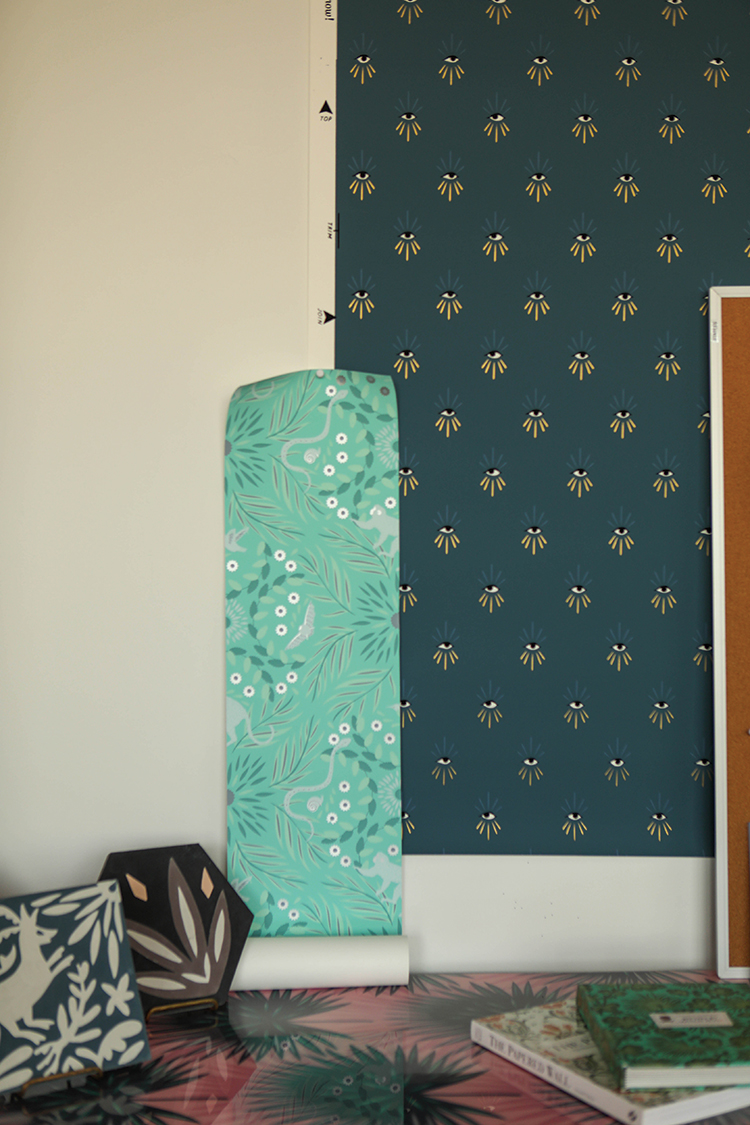
My thinking is less linear and more holistic. I do have a very organized and structured side of myself, but I’m constantly influenced and distracted by seemingly unrelated things. Sometimes these things become meaningful for my art, and sometimes they just take me on a little mental break, or a daydream. Sometimes I have too many ideas, and it’s agonizing to narrow them into one pattern or piece. Having the discipline to work that out has been hard earned.
For me, my creative passion is learning. Creating something is always an opportunity to learn something new. Whether it’s honing my craft or simply researching a topic or visiting a new place, that influence is what excites me. I could have been as a professional student (OK, maybe that’s nostalgia talking), but at the very least, the experience of trying to make or express something new gets me super pumped up. I also love a challenge; I swear I pick the hardest road sometimes, and it can make me crazy. But, again, I tend to learn more (and better) that way.
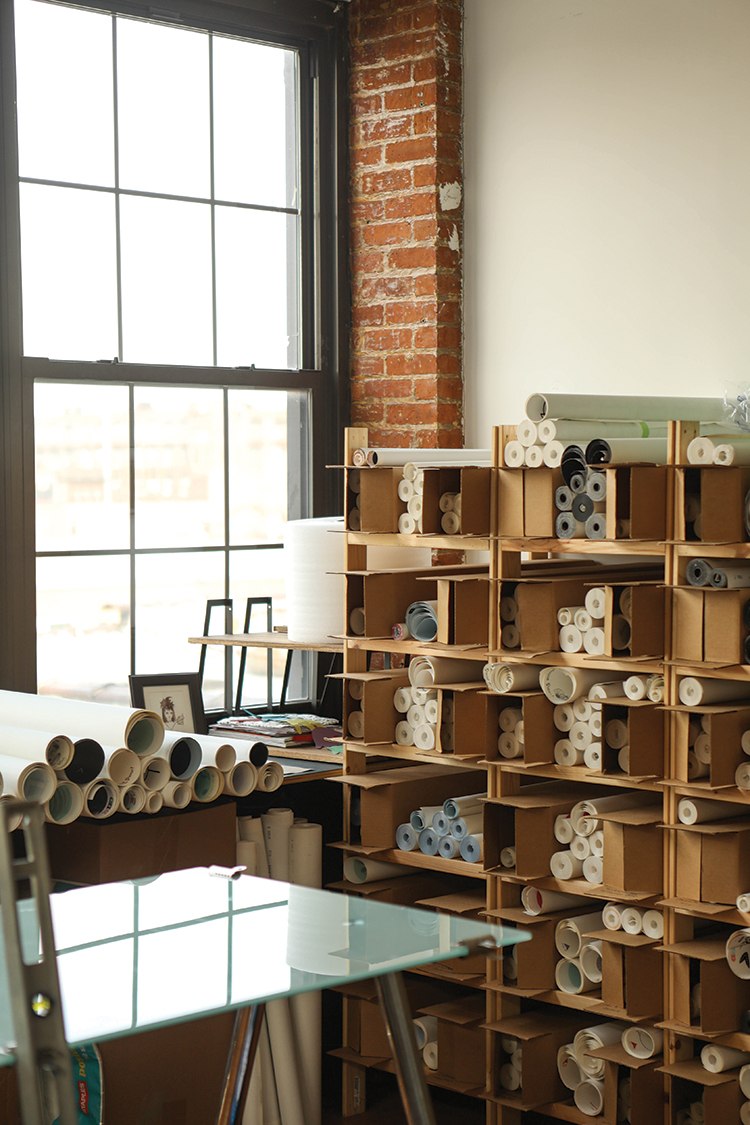
My creative community has formed over years of entrepreneurship. I’m friends with many of the local wallpaper designers here in Brooklyn, since we’re all working towards the same goal (growing wallpaper/pattern as a market and making beautiful things). These friendships have formed over years of figuring out how to start businesses, navigating trade shows, building press…all of it. And they are people I highly respect and can rely on for help and advice, even though on paper they might be considered the competition. Supporting each other is much more fulfilling.
There are few things more satisfying than the act of doing something you love. If it’s a creative pursuit, do it. Even if it’s in five-minute spurts, hiding in the bathroom. Our creative pursuits may not always be lucrative, but if they truly make us happy they can affect every corner of our lives. This way, whether success comes or not, you have the fulfilment of time spent doing something which adds to your well-being.
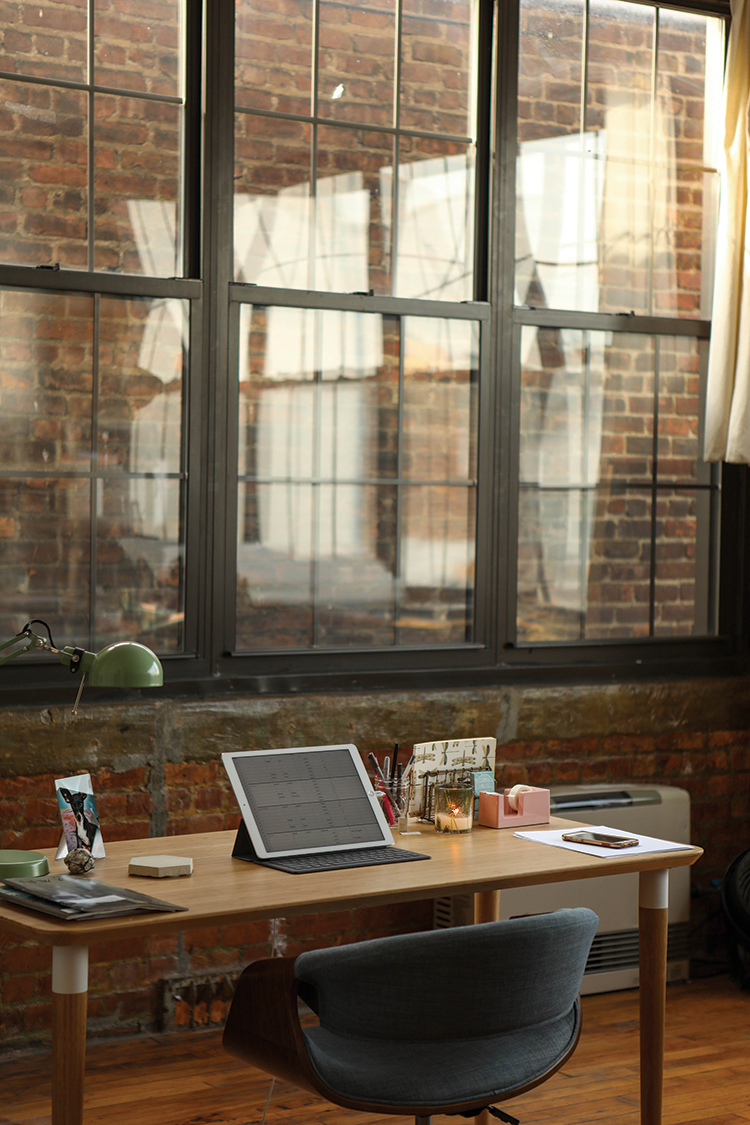
My current studio is actually pretty new! My last studio was cozier and darker (read: no windows), though we had a skylight installed to give me the natural light I needed when working with colors and designing. This time around, all I wanted was light. Our new studio is simple; it’s a home for our wallpaper stock, it’s where our shipping and receiving happens, and — more importantly — it’s a space that’s just mine, for thinking and drawing and working out ideas. Living in Brooklyn, every square inch is precious. At home, our space is limited and houses myself, my husband, and our daughter. Here, I can do whatever I want and let myself relax a little without staring down a bunch of dishes. At some point, I’ll be redesigning the space to have more qualities of a showroom; for now, it’s my happy place. Not to sound cliché, but it’s a room of my own (thanks, Virginia Woolf)!

My mom is from Cuba and my dad is from the Northeast, so it was a good balance growing up down South in Atlanta, GA. I moved on to NYC after graduating from college, and have been here in beautiful Brooklyn ever since. I do miss real sweet tea and hot boiled peanuts, though. And trees!
When I was four, I wanted to be an astronaut. It didn’t last long, because my earliest memory of wanting to be an “artist” came soon after, probably around five. I had no idea what that really meant, but it was what gave me the most joy and relieved my mind as I was growing up. I did a lot of drawing when I was young, as opposed to three-dimensional work. On that note, I also did a lot of deconstructing. I’d take old telephones, lamps, whatever was lying around in the basement and pull them apart to try to figure out how they worked. I was interested in both sides of the coin; makin’ and breakin.’

I always felt like having a story or a “meaning” behind my artwork was important. I began working towards a career in illustration for that reason. Ultimately that track wasn’t for me, but I still found a way to use my love of history, mysteries, cultures, and overall storytelling. My path led me to pattern making, which grew into wallpaper designs based on my various inspirations. I try to make work that is interesting or beautiful without knowing the story behind it, but in the end the narrative is what gives it depth.
Designing a wallpaper can take anywhere from a day to several months. It usually begins with a seed of inspiration; a strange place, an interesting story, or a surprising person from history. Whatever gets my curiosity walking down a new path. I spend a lot of time thinking about imagery and design that can relate to that person, place, event, or thing; what colors and pattern elements were used at that time and place? Throughout the process of designing wallpapers I am always sketching loosely on paper. I then refine my favorite drawings to create concepts that could be used for different wallpaper patterns.
Once we select a concept and finalize a wallpaper design, we transfer it into Adobe Illustrator so that I can quickly and easily create repeats and ensure alignment and flow. It took me a long time to be comfortable drawing on the computer, but with pattern work it’s an essential tool in the toolbox.
All of my pattern work is inspired by narrative, which enriches what I make.
The next step is to build our screens for printing. Each color on a pattern gets its own screen, which essentially acts as a stencil. Screen building is a technical art, and involves stretching fine mesh over a frame, coating it in a photosensitive film, and then transferring the design by using light to “burn” the image in. Most of our patterns have between two and six screens, which are numbered and layered in order to create the rich, textured pattern of the finished paper.

Once all the screens are shot, we take them to the print shop. The building we print in is an old converted bowling alley in upstate New York, situated on a lake and surrounded by a little town. Where the lanes once were, long tables have been built to give us enough space to print five consecutive rolls per table — about 75 feet. Each screen is quite large; the actual print on paper is 36″ × 30.”
The screen printing process is all done by hand, one color at a time with inks which are hand-mixed, which means slight variation can occur from batch to batch — but I prefer this method to a digital print any day. I’m a stickler for color, and can sometimes spend more time perfecting the exact hue I’m going for than creating the pattern itself. I often work from color swatches, but am always looking for color inspiration around me; old illustrations, rare bits of nature in the city, etc.

Each screen is smothered in the ink(s) and stenciled onto the paper until all 75 feet is glowing with pattern. Printing requires two people to ensure consistency and alignment. Each screen will go down the print table 25 times, which means some of our patterns will take 150 actual prints per table.
In a digital world where products seem to pop out of a machine whole, watching this process feels like magic. It’s also exciting seeing a small idea turn into a massive final product. The anticipation of getting that first batch of rolls in from the print shop will never, ever get old.
Once the colors are screened and the paper dries the long strips of wallpaper are then cut down into smaller bolts of two and three rolls. Because of the hand-mixed inks and the slight variations between print run we ensure that each order gets pulled from the exact same dye lot, so customers get a perfect match every time. The rolls are then packaged by hand for delivery.

Wallpaper lines included in our portfolio are our Sister City Collection (inspired by towns around the world and their historical and cultural connections), our Codex Collection (based on unusual and noteworthy manuscripts from around the world), and our Cuba Collection (pulled from family stories, as an autobiographical line).
I design handmade cement tiles as well. My family is Cuban, and I wanted to produce a traditional Cuban product in patterns that were a little more contemporary. These don’t have specific stories behind them, but they do have little inspirations. They’ve been a wonderful way for me to think differently about pattern — the way the layouts work are much different than wallpaper. They’ve been a wonderful addition to my product line!

In some cases, the cement tiles are intended to support a wallpaper pattern; for example, our most popular tile — Otomi — is essentially the same pattern as our Jardin wallpaper, but with a slightly different scale and layout. Most customers will use the tiles and wallpapers independently of one another, but when our products are used in the same space it’s an additional layer of texture. We can also color match our tiles to the wallpapers, which can tie the two together as well.
Other times, the tiles stand alone, such as our Tropicana tile. This tile pattern was part of our Cuba Collection, of which we have several wallpapers, but its design was inspired by the open-air Tropicana nightclub during Havana’s golden days. It’s intended to evoke elegant and playful dancing under the stars; and while it’s inspired by a similar place as the wallpapers in our Cuba collection, its design is all its own.

My thinking is less linear and more holistic. I do have a very organized and structured side of myself, but I’m constantly influenced and distracted by seemingly unrelated things. Sometimes these things become meaningful for my art, and sometimes they just take me on a little mental break, or a daydream. Sometimes I have too many ideas, and it’s agonizing to narrow them into one pattern or piece. Having the discipline to work that out has been hard earned.
For me, my creative passion is learning. Creating something is always an opportunity to learn something new. Whether it’s honing my craft or simply researching a topic or visiting a new place, that influence is what excites me. I could have been as a professional student (OK, maybe that’s nostalgia talking), but at the very least, the experience of trying to make or express something new gets me super pumped up. I also love a challenge; I swear I pick the hardest road sometimes, and it can make me crazy. But, again, I tend to learn more (and better) that way.

My creative community has formed over years of entrepreneurship. I’m friends with many of the local wallpaper designers here in Brooklyn, since we’re all working towards the same goal (growing wallpaper/pattern as a market and making beautiful things). These friendships have formed over years of figuring out how to start businesses, navigating trade shows, building press…all of it. And they are people I highly respect and can rely on for help and advice, even though on paper they might be considered the competition. Supporting each other is much more fulfilling.
There are few things more satisfying than the act of doing something you love. If it’s a creative pursuit, do it. Even if it’s in five-minute spurts, hiding in the bathroom. Our creative pursuits may not always be lucrative, but if they truly make us happy they can affect every corner of our lives. This way, whether success comes or not, you have the fulfilment of time spent doing something which adds to your well-being.

My current studio is actually pretty new! My last studio was cozier and darker (read: no windows), though we had a skylight installed to give me the natural light I needed when working with colors and designing. This time around, all I wanted was light. Our new studio is simple; it’s a home for our wallpaper stock, it’s where our shipping and receiving happens, and — more importantly — it’s a space that’s just mine, for thinking and drawing and working out ideas. Living in Brooklyn, every square inch is precious. At home, our space is limited and houses myself, my husband, and our daughter. Here, I can do whatever I want and let myself relax a little without staring down a bunch of dishes. At some point, I’ll be redesigning the space to have more qualities of a showroom; for now, it’s my happy place. Not to sound cliché, but it’s a room of my own (thanks, Virginia Woolf)!
















